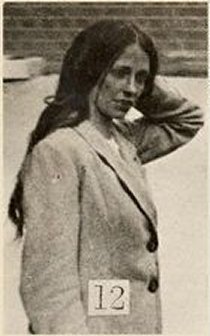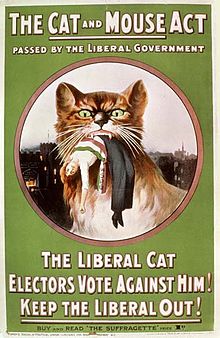Lilian Lenton
Lilian Ida Lenton (born January 5, 1891 in Leicester , † October 28, 1972 in Twickenham ) was an English dancer and suffragette . She campaigned, sometimes with radical means, for women's rights .
Life
youth
Lilian Ida Lenton was born in Leicester in 1891, the eldest daughter of the carpenter and joiner Isaac Lenton and his wife Mahalah Bee. She had four siblings and was the oldest. After graduating from school, she began training as a dancer and took on the name Ida Inkley .
Act as a suffragette
Lenton, already a member of the Women's Social and Political Union (WSPU), heard Emmeline Pankhurst speak and actively campaigned for women's suffrage. On March 4, 1912, she took part in a demonstration aimed at breaking windows in the government building in Whitehall. She was arrested along with 200 other suffragettes for participating in the demonstration. She was then sentenced to two months in prison under her pseudonym Ida Inkley and was sent to Holloway Prison .
After her release from prison, she helped Rosa May Billinghurst damage mailboxes; More than 5,000 letter boxes and the letters in them are said to have been damaged by paint bags thrown into post boxes.
From July 1912 she belonged to the group around Christabel Pankhurst , who carried out arson attacks in which empty buildings or churches were the targets. Lenton was involved in several arson attacks and was arrested along with Olive Wharry on February 19, 1913 , shortly after they set fire to the tea pavilion in Kew Gardens . Shortly before their arrest, they were watched by police throwing bags away; in these were a hammer, a saw, a bundle that smelled strongly of paraffin and paper that smelled of tar. The other bag was empty, but it appeared to have contained flammable materials.
Detained again, Lenton went on a hunger strike and was force-fed through a tube into her nose on February 23 . Food got into her lungs and she became seriously ill with pneumonia. Due to her health, she was released into the care of friends in Harrington Square and was able to recover there. After that, she initially managed to evade arrest again until she was arrested in Doncaster in June 1913 . The charge was that they set fire to the train station in Blaby , Leicestershire . She was detained at HM Prison Leeds and immediately went on another hunger strike. After a few days, she was released under the Cat & Mouse Act . A short time later she was able to escape to France on a private yacht.
A short time later, Lenton was back in England. As an arsonist, she continued her work and set herself the goal of setting fire to two buildings a week in order to seriously endanger the structure of the state. She was arrested and imprisoned as early as October 1913 when she went to pick up a bicycle at Paddington station . She went on a hunger strike, was force-fed, and became seriously ill. Due to the illness, she was released on October 15 and was taken care of by Mrs. Dioplock in her home, The Limes . She escaped from the nursing home and set fire to homes again, and was arrested in an arson attack on a house in Cheltenham on December 22, 1913. While in detention, she went on a hunger strike and was released on December 25th into the care of Ms. Impey in Kings Norton . From there she also fled, escaped the police and was arrested in Birkenhead in early May 1914 . After a few days in prison, she was released under the Cat & Mouse Act.
First World War
England declared on August 4, 1914 Germany war . Just two days later, the National Union of Women's Suffrage Societies announced that they would suspend all political action until the war ended. The leadership of the Women's Social and Political Union also began to work with the government, and on August 10 the government announced that all suffragettes imprisoned would be released. Emmeline Pankhurst stated that she would cease her militant resistance and declare herself ready for military service. After Evelina Haverfield , another member of the WSPU, the Women's Emergency Corps was founded to organize women as doctors, nurses and Motorradbotinnen, located Lenton Haverfield joined and went in August 1916, her Elsie Inglis , Elsie Bowerman and Vera Holme on the front in the Balkans. She worked as a nurse in Serbia and was assigned to Elsie Inglis' Scottish Women's Hospitals for Foreign Service . She was awarded the French Red Cross medal for her work.
Later years
On March 28, 1917, the House of Commons decided by 341 votes to 62 that women over the age of 30 owned a home or were the wives of a homeowner, owned properties with an annual rent of £ 5, or were graduates British university that should get the right to vote. After the law was passed, women were allowed to vote in parliamentary elections for the first time in December 1918. Several women ran for office in December, only Constance Markiewicz , who was still in prison at the time, was elected. Lenton herself could not vote long after the introduction of the right to vote because she was neither married nor owned property. In 1928 women in Britain were given equal voting rights. Lilian Lenton was 37 years old at the time.
After the war, Lilian Lenton worked for the British Embassy in Stockholm and for Save the Children in Russia, and from 1924 to 1933 as a tour operator and spokesperson for the Women's Freedom League . For some time she lived in Scotland and campaigned for animal rights. After 1953, she was the financial secretary of the National Union of Women Teachers .
Together with Edith How-Martyn , Lilian Lenton founded the Suffragette Fellowship , which documented the history of the women's rights movement.
In 1970, Lenton, as Treasurer of the Suffragette Fellowship, unveiled a memorial in Christchurch Gardens, Westminster, dedicated to all women and men who endured ridicule, resistance, exclusion, physical violence and suffering in order to give women the right to vote.
Lilian Lenton died in Twickenham on October 28, 1972 at the age of 81. In her obituary in The Times she was described as: The tiny, wily, elusive pimpernel.
literature
- Elizabeth Crawford: The Women's Suffrage Movement: A Reference Guide 1866–1928 . Routledge, 2003, ISBN 978-1-135-43402-1 , pp. 341 ( books.google.de ).
- Helen Jones: Women in British Public Life, 1914–50: Gender, Power and Social Policy . Routledge, 2014, ISBN 978-1-317-88931-1 , pp. 111 ( books.google.de ).
media
- Interview with Lilian Lenton 1955, BBC on the Suffragettes Anniversary
- Interview with Lilian Lenton 1960, BBC on the Cat & Mouse Act
Individual evidence
- ↑ a b Lilian Lenton. In: thesuffragettes.org. Retrieved February 15, 2019 .
- ↑ a b c d e f g h i Lilian Lenton. In: spartacus-educational.com. Spartacus Educational, accessed January 26, 2019 .
- ^ Sheila Hanlon: Police Sting on Lilian Ida Lenton's bicycle. In: sheilahanlon.com. 2011, Retrieved February 15, 2019 (American English).
- ↑ a b c d Crawford p. 341
- ↑ a b c d Lilian Lenton - the Leicester suffragette who the Home Secretary wanted stopped - Leicestershire La La La. In: leicestershirelalala.com. Retrieved February 16, 2019 (UK English).
Web links
- Lilian Lenton in the database of Find a Grave (English)
| personal data | |
|---|---|
| SURNAME | Lenton, Lilian |
| ALTERNATIVE NAMES | Lenton, Lilian Ida (full name) |
| BRIEF DESCRIPTION | British suffragette |
| DATE OF BIRTH | January 5, 1891 |
| PLACE OF BIRTH | Leicester |
| DATE OF DEATH | October 28, 1972 |
| Place of death | Twickenham |


